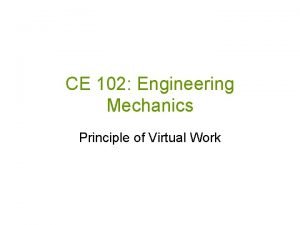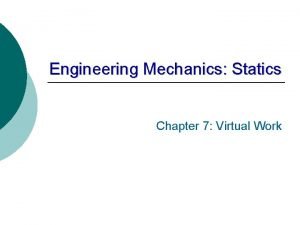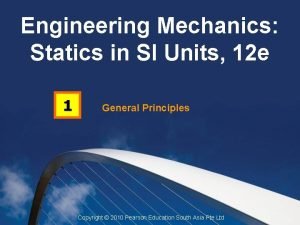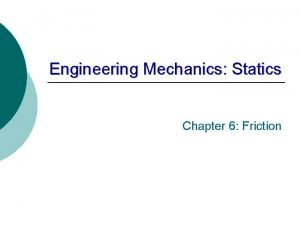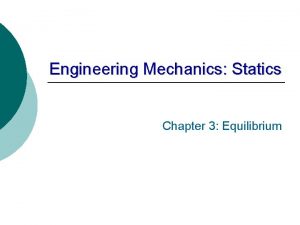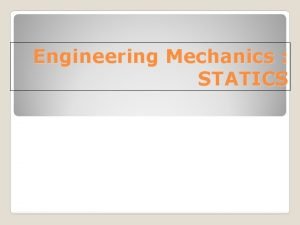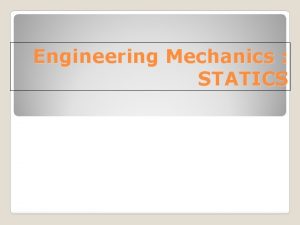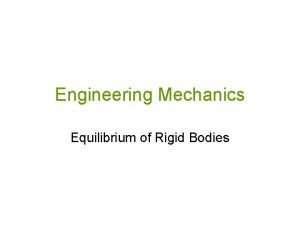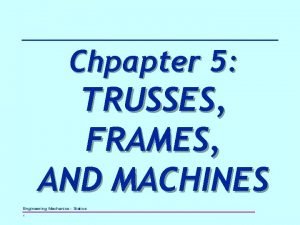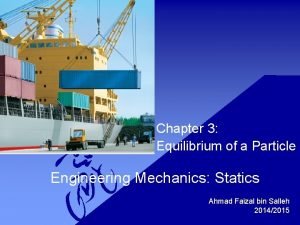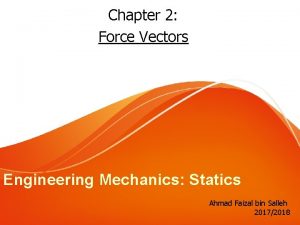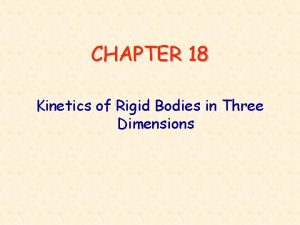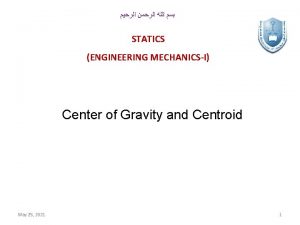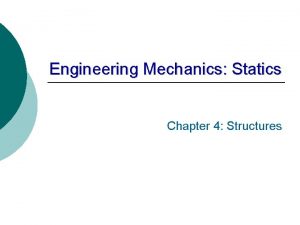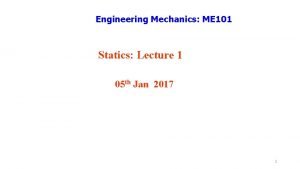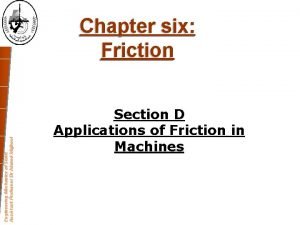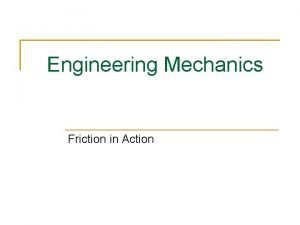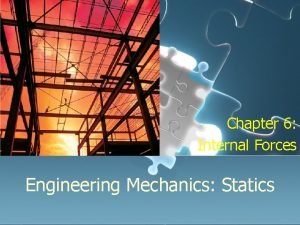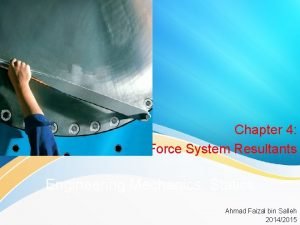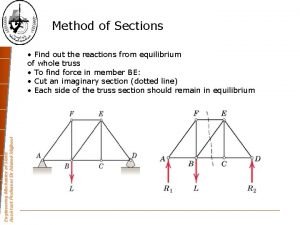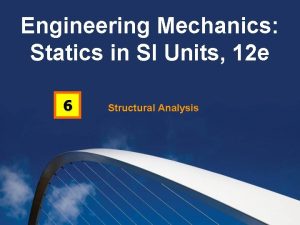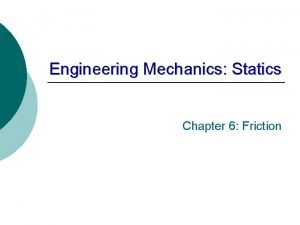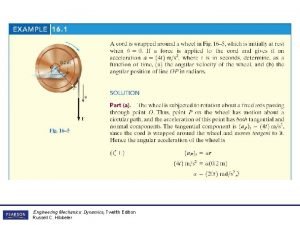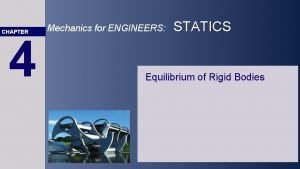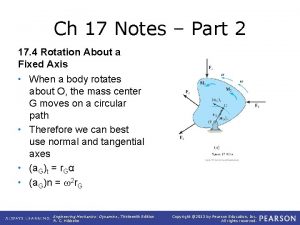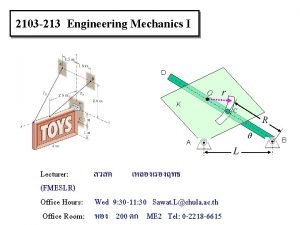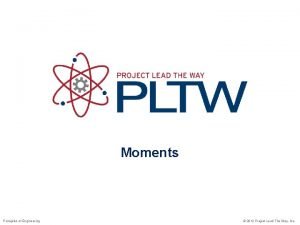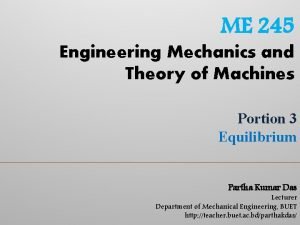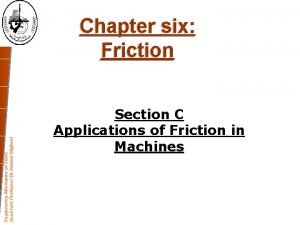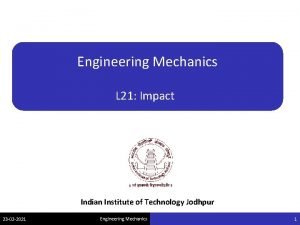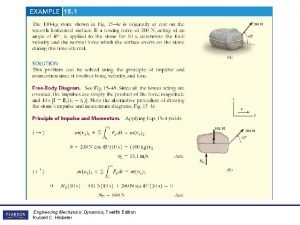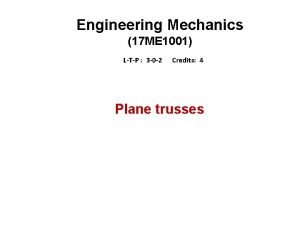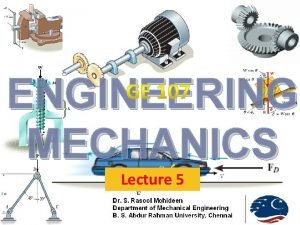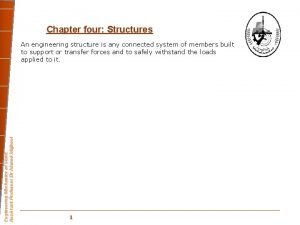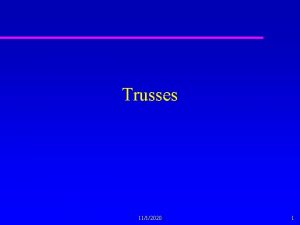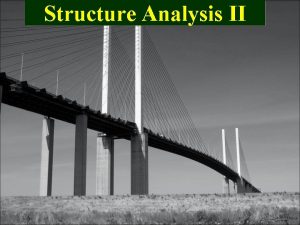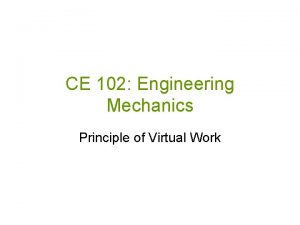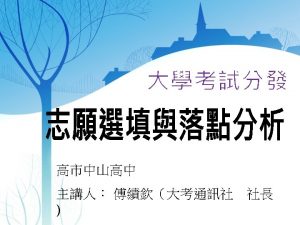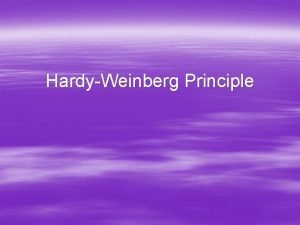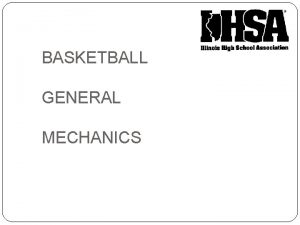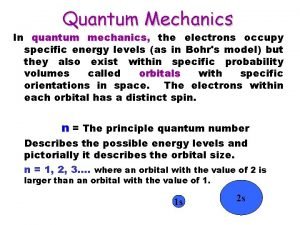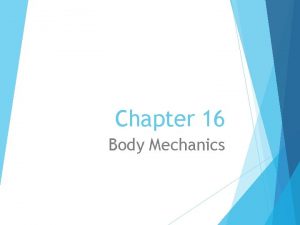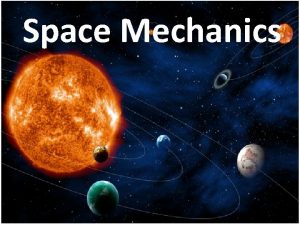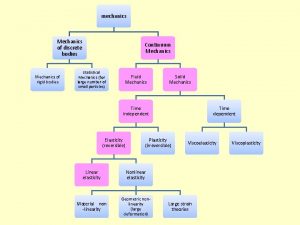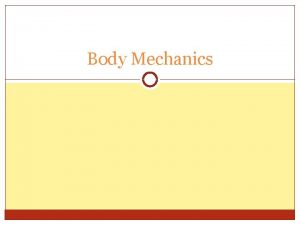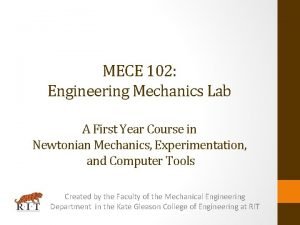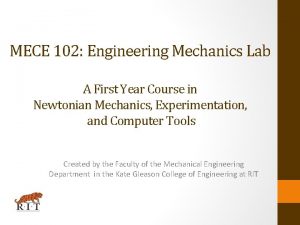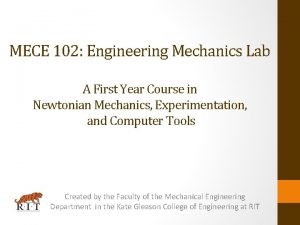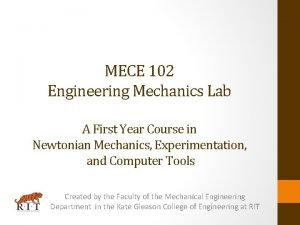CE 102 Engineering Mechanics Principle of Virtual Work







































- Slides: 39

CE 102: Engineering Mechanics Principle of Virtual Work

Work of a Force

Work of a Couple Small displacement of a rigid body: • translation to A’B’ • rotation of B’ about A’ to B”

Principle of Virtual Work • Imagine the small virtual displacement of particle which is acted upon by several forces. Principle of Virtual Work: • If a particle is in equilibrium, the total virtual work of forces acting on the particle is zero for any virtual displacement. • If a rigid body is in equilibrium, the total virtual work of external forces acting on the body is zero for any virtual displacement of the body. • If a system of connected rigid bodies remains connected during the virtual displacement, only the work of the external forces need be considered.

Virtual Work for a rigid body

Different types of forces • Forces that do work are called active force. • Reactive and internal forces do not do any work. • Virtual displacements are to be given carefully so that the active forces are only the known forces and the forces we are interested in obtaining • Similar to FBD we draw active force diagram (AFD).

Work of a Forces which do no work: • reaction at a frictionless pin due to rotation of a body around the pin • reaction at a frictionless surface due to motion of a body along the surface • weight of a body with cg moving horizontally • friction force on a wheel moving without slipping

Degrees of Freedom • DOF in this context is the total number of independent coordinates required to specify the complete location of every member of the structure. • For VW method in this course we will use only 1 -DOF systems. 1 DOF 2 DOF

To summarize • Principle of virtual work – The virtual work done by external active forces on an ideal mechanical system in equilibrium is zero for any all virtual displacements consistent with the constraints. • Ideal system: – All surfaces, joints etc. are frictionless. – We will deal with ideal system in this course. • Consistent with constraints: – The virtual displacement should be such that they should not do allow the non-active forces to do any work.

Why principle of Virtual Work • For complex mechanisms (we will solve some problems) we do not need to dis-member the system. • We obtain the active unknown force in one shot without bothering about the reactive forces. • Such type of analysis will be a stepping stone to VW analysis using deformations when you study Solid Mechanics, Structural Mechanics etc. not to mention powerful Approximate methods like the Finite Element Method.


Problem 1 • Assuming frictionless contacts, determine the magnitude of P for equilibrium This problem will be referred to as the Ladder problem


Problem 2 • The pressure p driving a piston of diameter 100 mm is 1 N/mm 2. At the configuration shown, what weight W will the system hold if friction is neglected This along with the ladder problem forms a framework for many other problems


Problem 3 • A hydraulic lift platform for loading trucks supports a weight W of 5000 N. Only one side of the system has been shown; the other side is identical. If the diameter of the piston in the cylinder (two) is 40 mm, what pressure p is needed to support W when θ = 60 o. Assume l = 240 mm, d = 600 mm, and e = 100 mm. Neglect friction everywhere


Problem 4 • A power-operated loading platform designed for the back of a truck is shown. The position of the platform is controlled by the hydraulic cylinder, which applies force at C. The links are pivoted to the truck frame at A, B, and F. Determine the force P supplied by the cylinder in order to support the platform in the position shown. The mass of the platform and the links may be neglected compared with that of the 250 kg crate with center of mass at G.


Problem 5 • A force P is applied to slider C as shown. The constant of the spring is 1. 6 k. N/m, and the spring is un-stretched when member BD is horizontal. Neglecting friction between the slider and the guide rod and knowing that BC = BD = 150 mm, determine the magnitude of P so that when the system is in equilibrium.


Problem 6 • Determine Q for equilibrium for the system shown. The pulleys are frictionless and have masses W 1 and W 2. The sliding body has mass W 3.

Problem 7 • Find the force Q required to maintain the system in equilibrium.

Problem 8 • Determine the couple M which must be applied at O in order to support the mechanism in the position θ = 30 o. The masses of the disk at C, bar OA, and bar BC are mo, m, and 2 m respectively.


Problem 9 • Determine force in member CD by using the method of virtual work.


Tutorial Problems

Problem 1 • Find reaction at E by using method of virtual work


Problem 2 • The elevation of the platform of mass m supported by the four identical links is controlled by the hydraulic cylinders AB and AC which are pivoted at point A. Determine the compression P in each of the cylinders required to support the platform for the specified angle θ


Problem 3 • Determine the vertical movement of joint C, if the member FG is lengthened by 50 mm



Problem 4 • Find the force delivered at C in the horizontal direction to crush the rock. Pressure p 1= 100 M -Pa and p 2= 60 M-Pa (measured above atmospheric pressure). The diameters of pistons are 100 mm each. Neglect the weight of the rods.


Extra Problem • Find the moment M required to hold the system in equilibrium. • Take P = 135 N, a = 600 mm, and θ = 40 deg.

 Virtual work engineering mechanics
Virtual work engineering mechanics The system is in equilibrium. find the angle q.
The system is in equilibrium. find the angle q. Has virtual functions and accessible non-virtual destructor
Has virtual functions and accessible non-virtual destructor Engineering mechanics: statics in si units answers
Engineering mechanics: statics in si units answers Cone of friction
Cone of friction Statics chapter 3
Statics chapter 3 Force system in engineering mechanics
Force system in engineering mechanics Center of gravity mechanics
Center of gravity mechanics Center of gravity statics
Center of gravity statics Fixed support
Fixed support Engineering mechanics trusses and frames
Engineering mechanics trusses and frames Particle equilibrium in 2d and 3d engineering mechanics
Particle equilibrium in 2d and 3d engineering mechanics Solve the vector product of 100j x 100k =?
Solve the vector product of 100j x 100k =? Kinetics of rigid bodies
Kinetics of rigid bodies Static mechanics
Static mechanics Chapter 4 statics
Chapter 4 statics Me 101 engineering mechanics
Me 101 engineering mechanics Centroid by integration
Centroid by integration Engineering mechanics
Engineering mechanics Belt friction
Belt friction Internal forces statics
Internal forces statics Force system resultants chapter 4
Force system resultants chapter 4 Mechanics static
Mechanics static The truss used to support a balcony is subjected to
The truss used to support a balcony is subjected to Engineering mechanics (9th) edition chapter 12 problem 30p
Engineering mechanics (9th) edition chapter 12 problem 30p Engineering mechanics
Engineering mechanics Mechanics for engineers
Mechanics for engineers Hibbeler
Hibbeler Engineering mechanics
Engineering mechanics Engineering moments
Engineering moments Simple machines engineering mechanics
Simple machines engineering mechanics Engineering mechanics
Engineering mechanics Engineering mechanics
Engineering mechanics Mechanics
Mechanics Plane truss and space truss
Plane truss and space truss Engineering mechanics
Engineering mechanics Engineering static
Engineering static Iit kharagpur virtual lab
Iit kharagpur virtual lab Virtual work method truss
Virtual work method truss Virtual work method truss
Virtual work method truss
